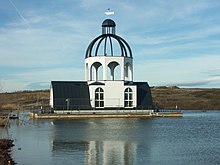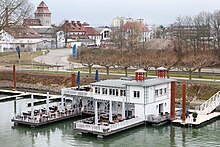Floating structure


A floating structure (depending on the design and use also floating structure , floating building or floating house called) is a structure which - supported by the buoyancy of floats (pontoons) - on the surface of a body of water floats . In contrast to watercraft , floating structures are primarily intended for stationary use. In addition to structures that float permanently, those that were only built to float for transport to the place of use and are lowered there with their lower part to the bottom of the water are also used. In individual cases, entire building complexes and settlements were built on floating islands .
So-called amphibious buildings are buildings on the mainland that are not firmly established, but are constructed to float and are set up in flood-prone areas. When there is a flood, such buildings are lifted by the buoyancy of the water and thus protected from flooding .
classification
Since a floating building structure is not permanently connected to the ground by a foundation , the technical and legal classification of such objects as structures and the demarcation of watercraft and floating devices is not clear:
Technical classification
Floating structures are usually intended to remain in the same place permanently or at least for a longer period of time. They are held in place by fastening them to dolphins , on the bank or on the ground or the like. The ability to swim is therefore not primarily used for spatial mobility , but only to support the structure, which, depending on the function of the structure, water depth, current and fluctuations in the water level, can be technically and economically more suitable than a solid foundation.
From a technical point of view, floating buildings differ from ships and other watercraft mainly in that they are not designed and equipped for " travel " , that is, movement from one place to another. Floating structures therefore usually do not have their own drive or their own control system , but rather have to be towed or pushed if they need to be transported over water . Also, in contrast to ships without their own propulsion , floating structures usually do not have the typical, aerodynamically elongated shape of a ship, but rather the rectangular floor plan of a house. Exceptions are former ships that have been decommissioned and converted into a building and floating structures that are placed in a strongly flowing body of water.
Floating buildings usually have a similar internal structure and building technology to buildings on land. They can be connected to the public supply and disposal networks (electricity, gas, water, telecommunications, ...) via a house connection .
Legal classification
Germany
The decisive criterion for classification as a building structure under public building law in Germany is not the fixed foundation, but the "(limited mobility) connection with the ground" and the "(predominantly) local stability", which in many floating structures is due to the attachment to the bank or reason can be taken for granted. However, the classification of floating systems is inconsistent, and depending on the type of system and location, individual consideration is required in case of doubt. Certain floating systems (which require approval according to water regulations ) are expressly excluded from the building codes of some German states (e.g. Hamburg, Mecklenburg-Western Pomerania, Schleswig-Holstein). In other countries (Berlin, Hamburg, Saxony-Anhalt and others), for example, houseboats, passenger ships and floating restaurants that are permanently moored on the bank are expressly subject to building permits in accordance with the building regulations.
According to German jurisprudence, however, a floating house ( houseboat , houseboat ) is generally not considered a building for tax purposes , i.e. it is not subject to property transfer tax or property tax .
Regardless of the validity of construction and tax law, floating systems are usually subject to water and shipping law and require appropriate classification, certificates, permits and permits.
For example, it says in the Inland Ship Inspection Regulations (BinSchUO):
“(1) The construction, equipment and facilities of a vehicle, a floating system and a float must meet the requirements of this Ordinance. [...]
(2) A moving floating installation or a moving float must also be technically approved for traffic, provided [...] the responsible waterways and shipping authority considers such a device to be necessary for reasons of safety and ease of traffic [...]. "
Similarly, floating systems are also included in the Inland Waterways Regulations (BinSchStrO), the Rhine Shipping Police Ordinance (RheinSchPV), the GDR's Maritime Trade Law and others. a. treated.
Examples
Examples of floating structures:
- Swimming investors , floating docks , floating loading terminals u. Ä.
- Floating bridges
- Floating docks
- floating offshore structures such as drilling , production or transformer platforms
- floating bathing establishments , bathing boats , river baths
- floating power plants ( floating wind turbines , wave power plants , flow power plants , etc.), also historical ( ship mills )
- Permanently moored floating houses , houseboats , barges , botels (hotel ships ), restaurant ships , church boats , etc. Ä.
Temporarily or permanently moored floating structures, on the other hand, are usually classified more as ships or floating devices:
- House boats
- Lightships and floating navigation signs (tons)
- Floating cranes , -bagger , jack-up platforms and similar work vessels that are only available for a limited time at a place
literature
- Horst Stopp, Peter Strangfeld: Floating residential buildings: Basics . Ed .: DIN eV Beuth-Verlag, 2012, ISBN 978-3-410-20406-0 .
Web links
Individual evidence
- ↑ Floating architecture. Modular and energy efficient. Kleusberg, accessed May 8, 2013 .
- ↑ a b c d Port Engineering Society , Working Committee marinas and water-tourism facilities (ed.): Recommendations for the design, construction and operation of marinas and water-tourism facilities . Advance deduction. Hamburg March 21, 2010, Chapter 9: Floating houses in sport boat harbors ( full text as PDF ). Full text as PDF ( Memento of the original from October 11, 2010 in the Internet Archive ) Info: The archive link was inserted automatically and has not yet been checked. Please check the original and archive link according to the instructions and then remove this notice.
- ↑ Amphibious houses float on the high water . In: Welt am Sonntag . February 18, 2007 ( full text in WELT's online archive ).
- ↑ Gerald Traufetter: Ark with gas connection . In: Der Spiegel . No. 39/2005 , September 26, 2005 ( full text in SPIEGEL's online archive ).
- ↑ a b FAQ. (No longer available online.) Floatinghouse.de, archived from the original on May 27, 2013 ; Retrieved May 8, 2013 . Info: The archive link was inserted automatically and has not yet been checked. Please check the original and archive link according to the instructions and then remove this notice.
- ↑ Floating house in Kiel. Baunetz Wissen - building technology, accessed on May 8, 2013 .
- ↑ a b Sebastian Veelken: planning permission for ships. nrw-baurecht.de, August 19, 2008, accessed on May 8, 2013 .
- ^ Gerhard Boeddinghaus, Dittmar Hahn, Bernd H. Schulte: The new building regulations in North Rhine-Westphalia: BauO NRW; [Hand comment] . 2nd Edition. Hüthig Jehle Rehm, 2000, ISBN 978-3-8073-1669-7 .
- ↑ District Office Hamburg-Mitte, Department of Economy, Building and Environment, Department of Urban and Landscape Planning, Department of Management of Public Space (Ed.): Approval Guide for Houseboats and Floating Houses in the District of Hamburg-Mitte . Hamburg September 2011 ( download as PDF ).
- ↑ Judgment: Floating structures are not buildings . In: Hamburger Abendblatt . November 2, 2012 ( full text in the online archive ).
- ↑ Floating structures, not buildings. (No longer available online.) Wüstenrot & Württembergische-Gruppe, October 30, 2012, archived from the original on December 4, 2014 ; Retrieved May 8, 2013 . Info: The archive link was inserted automatically and has not yet been checked. Please check the original and archive link according to the instructions and then remove this notice.
- ↑ Excise taxes: floating plants. Rechtslupe.de, December 14, 2011, accessed May 9, 2013 .
- ↑ Floating systems. (No longer available online.) Swiss Lloyd , archived from the original on December 4, 2014 ; Retrieved May 9, 2013 . Info: The archive link was inserted automatically and has not yet been checked. Please check the original and archive link according to the instructions and then remove this notice.
- ↑ a b Federal Ministry of Transport, Building and Urban Development; Department of Waterways and Shipping (Ed.): Leaflet: Floating moorings . Edition 2012. ( full text as PDF ).

